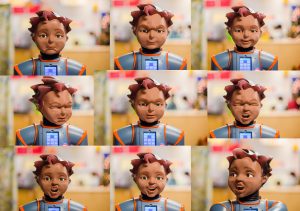
BY BRUCE MILLS
BRUCE@THEITEM.COM
Robots are slowly becoming an increasing part of our culture in the U.S., with much debate as to whether that’s good or bad.
But with this robot — which has the appearance of a human and helps increase social engagement for children with autism — there’s mounting research and evidence as to its effectiveness.
He’s Milo the Humanoid, and he’s at Kingsbury Elementary School in Sumter School District as part of a pilot study in the state.
Seventeen of South Carolina’s 81 public school districts are taking part in the three-year pilot study with Milo, who delivers a thorough social, emotional and behavioral research-based curriculum to students with autism. All costs associated with Milo and his software are paid with federal funding.
People with autism generally have challenges with social and emotional skills and may struggle with eye contact, interacting verbally with others and reading social cues, which all affect their ability to learn, said Julie Jeffcoat, lead teacher for special education at Kingsbury.
There’s a wide variation of challenges and strengths for each person with autism, Jeffcoat said. Some children, for example, are completely non-verbal, while others can communicate more easily.
Jeffcoat has been teaching children with autism at the school for 10 years and said Milo is revolutionary in the kids’ developmental process. Complete with 32 muscles in his face to model human facial expressions, Milo speaks at 82 percent of the speed of normal human speech and engages students with perfect eye contact and a predictable tone of voice in the learning process.
He models conversational greetings to adults and fellow children, how to act as a guest at a birthday party and other social interactions. Students practice the behaviors in working with Milo, and if they get it wrong, Milo will continue to present the topic in the same way, every time, with no change in his interaction.
“His reactions are very predictable and non-judgemental,” Jeffcoat said. “For a humanoid, Milo has compassion built into him, if that’s possible.”
Also with built-in camera sensors to detect changes in student behavior, Milo can discern when a student is getting emotionally upset and needs to calms down. He can model for them how to take a deep breath, count to 10 and even squeeze a stress ball.
Jeffcoat said in just more than a month, she has already seen progress in the students’ social communication and behaviors.
Jeffcoat noted that, with Milo’s assistance, some students can calm down now in five minutes, versus 30 to 40 minutes before.
Milo has been functioning and working with children at Kingsbury since mid-October. A total of 15 students with autism are in the pilot study at the school and will have specific performance data tracked by the robot throughout the year. Each student in the study has two 30-minute sessions per week with Milo. A teacher always sits behind the student and observes as a facilitator, according to Jeffcoat.
About 60 students have autism at Kingsbury, and all are getting at least some interaction with Milo, she said.
If students with autism can enhance their social, communication and behavioral skills, they can potentially transition into a mainstream classroom, Jeffcoat said.
Jeffcoat said it also helps that Milo is a “cool robot” because all youth are so involved with technology these days. Previous tools to aid students with autism were fairly outdated, including kits and puppets and other materials, she said.
“He’s a ground-breaker,” Jeffcoat said. “We haven’t had anything like this before. This is the first curriculum where we are simply facilitating, and the child and the robot are where the meat of it happens.”
Last week, Kingsbury fourth-grader Devon Lester, 9, went through a learning exercise with Milo in front of the district’s board of trustees.
His mother, Connie Lester, said she has been pleased with Devon’s progress since meeting Milo.
“I do see a difference with Devon,” Lester said. “He’s more engaged in conversation now than he was before.”